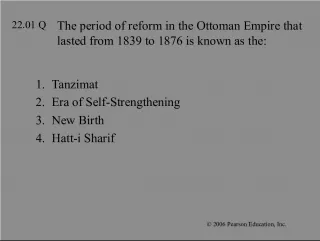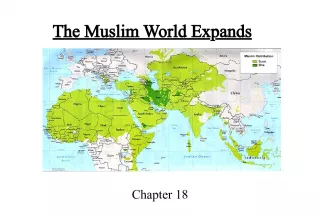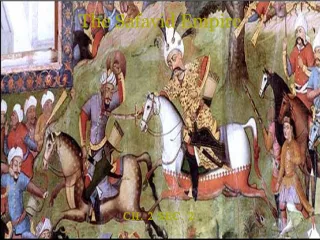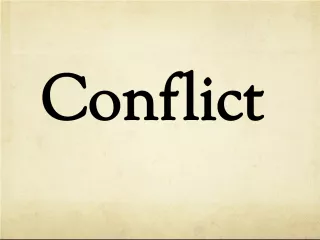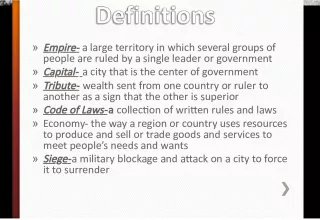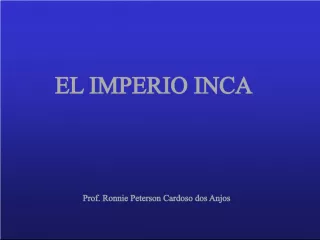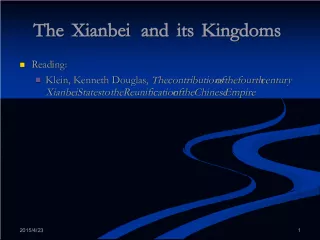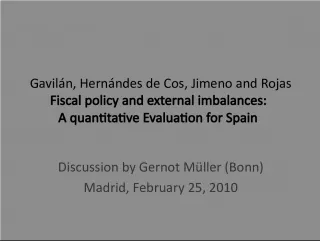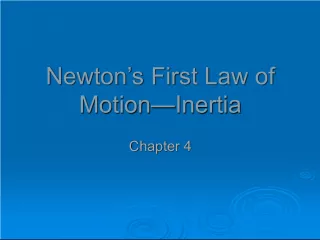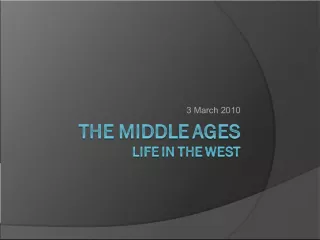The Decline of the Ottoman Empire: Internal Troubles and External Threats
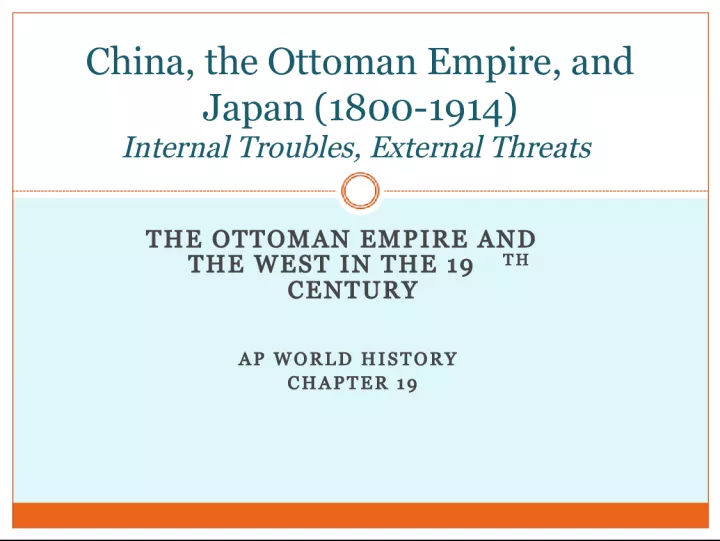

This chapter explores the decline of the Ottoman Empire in the 19th century, as it faced internal challenges and external invasions from European powers. The empire's inability to keep up with Western Europe and the rise of nationalism led to the loss of territories.
- Uploaded on | 0 Views
-
 priscilya
priscilya
About The Decline of the Ottoman Empire: Internal Troubles and External Threats
PowerPoint presentation about 'The Decline of the Ottoman Empire: Internal Troubles and External Threats'. This presentation describes the topic on This chapter explores the decline of the Ottoman Empire in the 19th century, as it faced internal challenges and external invasions from European powers. The empire's inability to keep up with Western Europe and the rise of nationalism led to the loss of territories.. The key topics included in this slideshow are Ottoman Empire, decline, internal troubles, external threats, European aggression,. Download this presentation absolutely free.
Presentation Transcript
1. THE OTTOMAN EMPIRE AND THE WEST IN THE 19 TH CENTURY AP WORLD HISTORY CHAPTER 19 China, the Ottoman Empire, and Japan (1800-1914) Internal Troubles, External Threats
2. The Ottoman Empire: Sick Man of Europe In the 1800s= the Ottoman Empire went from being a great power in the world to one of the weakest territories Could no longer keep up with Western Europe Unable to prevent region after region from falling under European control
3. Causes of Territorial Losses Cause #1 = European aggression Invasions from Russia, Britain, France, and Austria Example: one of the earliest invasions = in 1798 = Napoleons invasion of Egypt Cause #2 = Nationalism and independence movements by different groups within the Ottoman Empire Independence achieved by: Greece, Serbia, Bulgaria, and Romania (with help of European militaries) Driven by nationalism Napoleons Invasion of Egypt
4. The Contraction of the Ottoman Empire
5. More Problems for the Ottoman Empire Weak central government Increasing power of local authorities and rulers Unable to effectively raise revenue (taxes) Growing technological and military gap with Europe Decreasing power of the Janissaries (elite infantry units of the Ottoman Empire)
6. Economic Problems for the Ottoman Empire The economy of the Ottoman Empire weakened for several reasons: Europeans achieved direct sea access to Asia = no longer a need for them to go through the Ottoman and Arab land routes to get there = loss of revenue for those groups Ottoman artisans and workers hit hard by competition from cheap European manufactured goods An Ottoman Merchant in Istanbul (with no customers)
7. Economic Problems for the Ottoman Empire Series of unbalanced agreements between European powers and the Ottoman Empire = allowed Europeans many exemptions from Ottoman law and taxation Allowed these Westerners to easily infiltrate the Ottoman economy Ottoman Empire came to rely on foreign loans to sustain itself Unable to repay those debts OR the interest on them Led to foreign control of much of its revenue-generating system
8. The Ottoman Empire: Attempts at Reform Ottoman Empire began programs of defensive modernization Earlier, more sustained, and more vigorous than the self- strengthening policies of China Several factors contributed to this: The Ottoman Empire China No internal upheavals Taiping Rebellion Only nationalist revolts on edges of empire Peasant rebellions at the center of the state No explosive population growth Massive population growth Ottoman leaders = Turkic and Muslim (similar to their people) Chinas rulers = Qing rulers = Manchu (considered foreigners & NOT like their people)
9. The Ottoman Empire: Attempts at Reform Reforms began in the late 1700s with Sultan Selim III Wanted to reorganize and update the army Wanted to draw on European advisors and techniques Result = opposition from ulama (Muslim religious scholars) and the Janissaries Believed these reforms would threaten their power and that they conflicted with Islam Selim III = overthrown and murdered in 1807
10. The Ottoman Empire: Attempts at Reform Future sultans crushed the Janissaries and brought the ulama under state control Started the Tanzimat (reorganization) reform: Factories making cloth, paper, and arms Modern mining operations Resettlement of agricultural land Telegraphs, steamships, railroads, modern postal service Western-style law codes and courts New elementary and secondary schools Equal rights ( under law ) for Muslims AND non-Muslims The Ottoman Constitution, 1895 (Extended equal rights to all)
11. Supporters of Ottoman Reforms Supporters of these reforms = called the Young Ottomans Lower-level officials and military officers, writers, poets, journalists Had a new view of the Ottoman Empire = a secular state whose people were loyal to the dynasty that ruled it, rather than a state based on religion Wanted a European-style democratic, constitutional government Only way to overcome backwardness and stop European aggression
12. Supporters of Ottoman Reforms Islamic modernism = idea that Muslim societies can embrace Western technical and scientific knowledge, while rejecting its materialism Islam can be modern AND maintain its religious character
13. Supporters of Ottoman Reforms The Young Ottomans did not have much success authoritarian rule continued in the Ottoman Empire Young Turks = group of military and civilian elites Opposed this tyrannical rule Wanted a completely secular (non- religious) law code Supported continuing modernization based on European achievements Viewed the Ottoman Empire as a Turkish national state This antagonized non-Turkic peoples and helped stimulate Arab and other nationalisms contributed to disintegration of Ottoman Empire after WWI A photograph of Young Turks from 1902
14. Supporters of Ottoman Reforms 1908 = successful military coup by the Young Turks Reforms that they implemented: Secularized schools, courts, and law codes Allowed elections and political parties Established a Law of Family Rights for all people Opened up modern schools for women Allowed women to wear Western clothing Restricted polygamy Allowed women to get divorces in some situations Encouraged Turkish as the official language Declaration of the Young Turk Revolution
15. Comparing China and the Ottoman Empire Both shared several similarities by the beginning of the 20 th century: Both semi-colonies within the informal empires of Europe Both were hurt by a rapidly shifting balance of global power Kept formal independence Attempted to modernize, but never truly succeeded; no industrial economies No restoration of a strong state Both gave rise to new nationalist views of society Both empires officially collapsed in the early 20 th century
16. Comparing China and the Ottoman Empire There were also key differences between China and the Ottoman Empire in the aftermath of European imperialism: China The Ottoman Empire Collapse of the Chinese empire in 1911 was followed by a revolutionary upheaval that led to a communist government by 1949 Collapse of the Ottoman Empire was followed by the creation of new, smaller nation-states including Turkey Rejection of Confucian culture - Viewed as secular and elitist - Confucianism was always tied to a single state (China); not thriving elsewhere Islam retained a hold on civilization - Islamic religious tradition = personally meaningful to its followers - Islam = never tied to a single state; many independent centers
